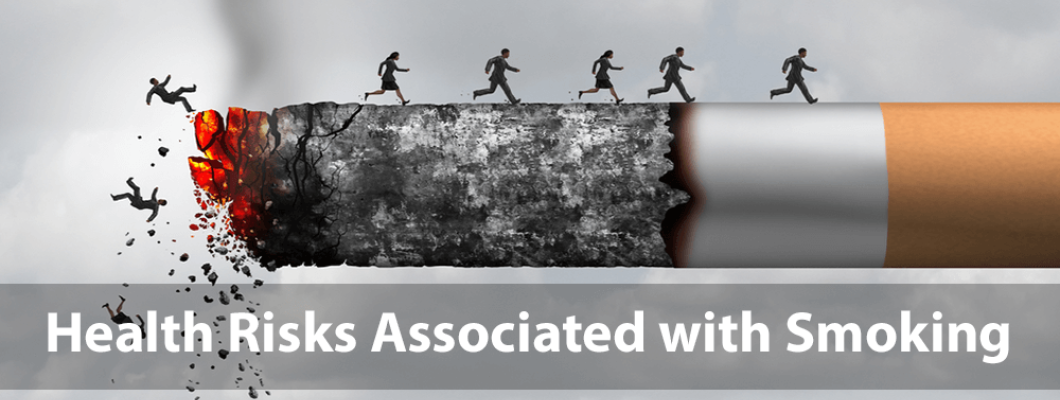
According to the Centers for Disease Control and Prevention (CDC), diseases caused by smoking kill more than 480,000 people in the U.S each year. Smoking is responsible for almost 90% of lung cancer and COPD deaths. Even with antismoking campaigns and health warnings, many people continue to smoke or start to smoke every year.
RISK OF SMOKING CIGARETTES:
Smoking increases the risk of lung disease, including lung cancer. Moreover, they also increase their risk of other diseases such as cardiovascular diseases, stroke, and mouth cancer.
HEALTH RISKS OF SMOKING CIGARETTE:
Smoking creates adverse health effects on the body that can be long term and even stand by lifetime. Here are some of the most dangerous long term health effects of smoking that can harm you severely are listed below:
RESPIRATORY SYSTEM:
Smoking cigarettes can cause serious respiratory diseases and impact on the body. Some of its effects and adverse diseases are listed below:
- Smoking can irritate the windpipe and larynx.
- It can reduce lung function and breathlessness due to narrowing of the lung airways impairment of the lungs clearance system leading to the increase of poisonous substances, which results in lung irritation and damage.
- Smoking also increases the risk of lung infection, coughing, and wheezing.
- Eventually, it can cause permanent damage to the airbags of the lungs.
COPD:
COPD, or chronic obstructive pulmonary disease, is the name for long-term lung disease, which includes both chronic bronchitis and emphysema (discussed below). The risk of COPD goes up increases as you smoke more and how much longer you smoke. It gets worse over time, and there is no cure.
Here are some facts about COPD:
- COPD is the fast-growing and adverse third leading cause of death in the United States.
- Smoking is undoubtedly the most common and adverse cause of COPD.
- More women die from COPD than men.
Noises in the chest (such as wheezing, rattling, or whistling), shortness of breath during activity, and coughing up mucus (phlegm) are some of the early signs of COPD. The last stage is one of the most dangerous phases of all illnesses. It makes people stop breathing and feel as if they are drowning.
CHRONIC BRONCHITIS:
Chronic bronchitis is a type of COPD. It’s a disease where the airways make too much mucus, forcing the person to cough it out. It’s a common problem for smokers. The airways become inflamed (swollen), and the cough becomes chronic (long-lasting). The symptoms can get better at times, but the cough keeps coming back. Over time, the airways get blocked by scar tissue and mucus, which can lead to lousy lung infections (pneumonia).
There’s no cure for chronic bronchitis, but quitting smoking can help keep symptoms under control.
EMPHYSEMA:
Emphysema is the other type of COPD. It slowly destroys a person’s ability to breathe. Usually, the lungs contain millions of tiny air sacs that help oxygen get into the blood. In emphysema, the walls between these air sacs break down and create larger pouches. This lowers the amount of oxygen reaching the blood. Over time, these sacs can break down to the point where a person with emphysema must work very hard to get enough air, even when at rest.
People suffering from emphysema are at considerable risk for many other problems linked to weak lung function, which can cause pneumonia too. In later stages of the disease, patients can only breathe comfortably with oxygen.
SMOKERS COUGH:
Tobacco smoke contains thousands of chemicals that irritate and disturb the airways and lungs, causing serious diseases. When a smoker intake these carcinogenic substances, the body tries to get rid of them by making mucus that proves to be helpful. The early morning smoker’s cough happens for many reasons. Usually, tiny and small hair-like structures (called cilia) in the airways help sweep and clean harmful material out of the lungs. But tobacco smoke slows the sweeping action, so some of the particles in the smoke stay in the lungs and mucus stays in the airways. While a smoker sleeps (and doesn’t smoke), some cilia recover and start working again. After waking up, the smoker usually coughs because the lungs are trying to sweep away the irritants and mucus.
HOW DOES SMOKING CAUSE CANCER?
Lung cancer had the most significant percentage of deaths attributable to smoking with 80.2%, followed by the larynx (voice box) cancer with 76.6%. About the ends from the oral cavity and throat cancer, there are many more types of cancer that are attributing to smoking like esophagus cancer and bladder cancer were attributable to smoking. Percentages for the other cancer types studied ranged from 23.6% for liver cancer to 9.7% for colon and rectal cancer.
- Poisons and chemicals in cigarette smoke can weaken the body’s natural immune system, making it much more complicated and harder to kill cancer cells.
- Carcinogenic materials in tobacco smoke can severely damage or change a cell’s DNA. DNA is the cell’s main constituent that controls a cell’s healthy growth and function.
Although lung cancer was a rare couple of years ago, now it has become a significant cause of death and cause heart disease as the leading cause of smoking-related mortality. The NCI estimates that smokers have twenty times greater risk for lung cancer. Increase to secondhand smoke is also a significant risk factor for lung cancer.
SMOKING AFFECT TO BRAIN
Brain scans revealed that former smokers had a thinner cortex than those people who never smoked. The cortex is where essential thought processes such as memory, language, and perception occur.
The researchers also found that stopping smoking leads to restoration of the cortex thickness, but the process is much slower and incomplete. Researchers have found that heavy ex-smokers who had not smoked for twenty-five years had comparatively thinner cortex


-400x300-400x300-400x300.png)


Leave a Comment